

Hello Woodcarvers!
I will begin by introducing myself and offer a brief outline of
how I became involved in the art of woodcarving.
My name is Vern Robinson a.k.a. The Stick Man. The a.k.a. came after years of walking with a cane. I am 42 years young, and live in the vast and beautiful country north of Ontario, Canada; in Thunder Bay to be exact. I came to Thunder Bay in 1995 to attend Lakehead University. I graduated in 1999 with an HBSW, Honors Bachelor of Social Work.
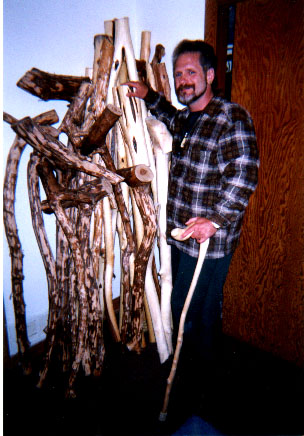 In 1984 I was involved
in a serious motor cycle accident. Some may say, "Oh that's
terrible," or, \"How unfortunate," however I see
it as a gift. The accident, like a large chisel, changed my shape
and form. I was not unlike a large cracked piece of wood. The
question was, do I discard this damaged piece/life, or do I work
with the unusual form, and see this as an opportunity to explore
something new. It took several years for me to finally accept
the gift, and to realize that there is potential in all things.
In 1984 I was involved
in a serious motor cycle accident. Some may say, "Oh that's
terrible," or, \"How unfortunate," however I see
it as a gift. The accident, like a large chisel, changed my shape
and form. I was not unlike a large cracked piece of wood. The
question was, do I discard this damaged piece/life, or do I work
with the unusual form, and see this as an opportunity to explore
something new. It took several years for me to finally accept
the gift, and to realize that there is potential in all things.
This is where woodcarving came into play. One beautiful day while sitting in a wheelchair outside my home, I noticed a stick on the front lawn. I wheeled over to it and noticed it had come from the maple tree above. It was a good size piece of wood, so I dragged it over to the patio, pulled out my pocketknife and began to whittle. I stripped the bark first, then started to carve. Well when I was completed, I had a mother and baby whale, a wolf head, an elephant head, a dove, a cougar head, a parrot, and a deer, all on one cane. Some of the animals were done in the round, and others were relief. This was the beginning of something I would have never imagined.
This first project/cane not only helped me in my efforts to walk; it was also a very needed crutch that silently offered emotional and mental support. How ironic, that something as simple as a fallen and soon to be discarded broken branch would play such a key role in my life.
Once that first cane was completed I began searching for other fallen branches. At times local residents would drop by with a stick they had found and offer it to me as a gift. At one point I had all the local children bringing me every stick they would find, including twigs. It was quite funny at times. My search eventually took me to local forests. My relationship with the forest grew, I had found my truth, and I had found a spiritual realm that was unlike anything I had ever experienced. Within my own understanding and connection with all of creation, I stood humbly in the forest and asked for guidance. Today and everyday I give thanks to nature, to creation, and stand in awe of its magnificence.
Carving is an integral part of my daily living. My dog Zephyr and I hike the woods to find great sticks and share in the joys of nature and woodcarving.
The hammer falls purposefully upon the chisel
Gliding and cutting shape and form
With one deep undeniable gouge
A new reality is revealed
Once again we hold it to an unsympathetic
light
There the fallen chips in time
And the dust of destiny
Unveil a form of distinct truth
Again the hammer falls
The chisel cuts
The gouge digs deep
And the light is unsympathetic
We look deeply into this sculpted form
Searching
Then the light gently illuminates
The sculpture is me
I am not perfect but I am beautiful
Vern Robinson June 21,2000
So now you have an idea
of who I am, let me show you what I do. The following photos are
a step by step illustration of the processes involved in my efforts
to complete a commission from photos of a pet.
 If I can not meet
with the person and their companion/pet, the emails and phone
calls can be quite lengthily. I like to get to know the person,
their needs and wants. I also want to know as much as possible
about their pet. Each animal has his or her own special character
and unique features. I do my best to capture that uniqueness.
If I can not meet
with the person and their companion/pet, the emails and phone
calls can be quite lengthily. I like to get to know the person,
their needs and wants. I also want to know as much as possible
about their pet. Each animal has his or her own special character
and unique features. I do my best to capture that uniqueness.

Once I receive photos of the pet, I must then select the piece of wood. This involves a process of elimination. I have to take into consideration the client's size, what the stick will be used for, and the animal that I will be carving. Sometimes the piece just jumps right out, and other times it may take several days to select the right piece.
Now it is time to take a walk with the stick
and photos, find a comfortable place to sit outside, and ask the
animal spirit to join me and guide my hand. I also thank the trees
for their gift of wood. Now I am ready to begin.
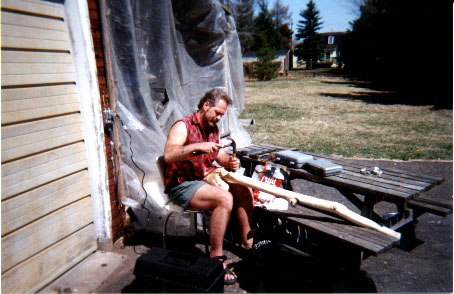 At present my workshop
is a picnic table in the back yard, so I set up all my tools on
the table, set up the photos, take a final look at the unique
shapes the wood presents and begin carving.
At present my workshop
is a picnic table in the back yard, so I set up all my tools on
the table, set up the photos, take a final look at the unique
shapes the wood presents and begin carving.
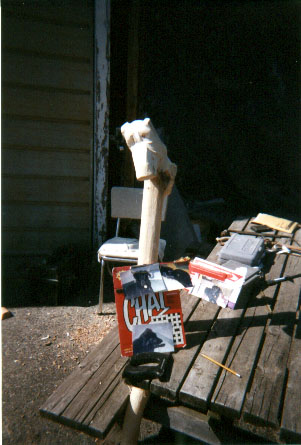 I begin by realizing
where the outer-most points will be. For example, with this dog,
Taz, I began by shaping the snout and nose area, then moved to
the crown of her head and her ears. All of these areas are the
outer-most points of the sculpture. From here I can then start
on the shaping of her head. The process is very slow; I remove
small bits of wood at a time, working on one side and then the
other in order to achieve balance. I never look for perfection
in terms of symmetry, but a nice balance.
I begin by realizing
where the outer-most points will be. For example, with this dog,
Taz, I began by shaping the snout and nose area, then moved to
the crown of her head and her ears. All of these areas are the
outer-most points of the sculpture. From here I can then start
on the shaping of her head. The process is very slow; I remove
small bits of wood at a time, working on one side and then the
other in order to achieve balance. I never look for perfection
in terms of symmetry, but a nice balance.
 Once I have her roughed
out, I can begin with the smaller details, that is, the nose,
mouth, eyes and eyebrows. The shape and size of the eyes is so
important. Many of the photos I am given for commissioned works,
are taken at different times, thus the animal has a different
expression. So, before I begin I must know what expression it
is that I am attempting to capture. One thing that I have learned
over the years is to always leave room for change. What I mean
by this is, as you are creating say the eye sockets, don't make
them too large because as you continue with the project you may
realize that the width of the head is just a little too big; then
when you go to narrow the head it just won't work as you have
created eye sockets that are too large. The same applies to the
nose and ears. Remember you can always make something a little
smaller, but you can't make it bigger.
Once I have her roughed
out, I can begin with the smaller details, that is, the nose,
mouth, eyes and eyebrows. The shape and size of the eyes is so
important. Many of the photos I am given for commissioned works,
are taken at different times, thus the animal has a different
expression. So, before I begin I must know what expression it
is that I am attempting to capture. One thing that I have learned
over the years is to always leave room for change. What I mean
by this is, as you are creating say the eye sockets, don't make
them too large because as you continue with the project you may
realize that the width of the head is just a little too big; then
when you go to narrow the head it just won't work as you have
created eye sockets that are too large. The same applies to the
nose and ears. Remember you can always make something a little
smaller, but you can't make it bigger.
 Vern and Zephyr
take a much-needed break!
Vern and Zephyr
take a much-needed break!
 Well I now have the
structure completed, I am happy with the expression, and I can
now put the eyes in. The glass eyes are ordered from a taxidermy
supplier. The eyes are always larger than the holes I have created,
in this way I get a close fit and realistic look. I use a mixture
of sawdust and wood glue and create a putty like adhesive. Once
I fill the eyes sockets with this putty, I then maneuver the eyes
in, and use a dentists pick tool to clean and adjust the eyes
so that they are looking in the direction I want. I then let it
sit over night and harden. Touch wood, I have never had a cross-eyed
dog yet.
Well I now have the
structure completed, I am happy with the expression, and I can
now put the eyes in. The glass eyes are ordered from a taxidermy
supplier. The eyes are always larger than the holes I have created,
in this way I get a close fit and realistic look. I use a mixture
of sawdust and wood glue and create a putty like adhesive. Once
I fill the eyes sockets with this putty, I then maneuver the eyes
in, and use a dentists pick tool to clean and adjust the eyes
so that they are looking in the direction I want. I then let it
sit over night and harden. Touch wood, I have never had a cross-eyed
dog yet.
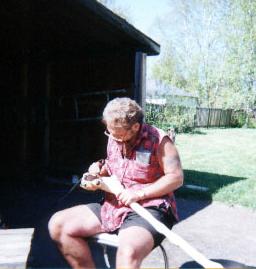 Now I think it is
time to begin the wood burning process (pyrography). When I enter
into an agreement with a client I request a variety of clear photos
from a number of angles. These photos must show the texture and
direction of the animal's coat. I usually begin by burning the
nose, around the eyes, and the hair/fur around the nose. This
gives me a good starting point and direction. Each animal is different,
and may have fur on one side of his/her face, going in a different
direction than on the other side. Wood burning also creates texture;
you can create layers and depth. You can also hide little imperfections.
I have been wood burning for three years now and learn something
new each time I pick the tools up. And what I learned on this
project was, that creating texture and depth can change what you
thought was the correct structure. Meaning, I was two-thirds completed
with the burning process when I realized that it was not shaping
up the way I expected. Something was wrong, so I started working
on the shaft of the stick for a few days, until I had enough courage
to remove most of the wood burning I had done, and begin the reshaping
process. This was a very difficult choice, but one that had to
be made, but happy to say it worked out well.
Now I think it is
time to begin the wood burning process (pyrography). When I enter
into an agreement with a client I request a variety of clear photos
from a number of angles. These photos must show the texture and
direction of the animal's coat. I usually begin by burning the
nose, around the eyes, and the hair/fur around the nose. This
gives me a good starting point and direction. Each animal is different,
and may have fur on one side of his/her face, going in a different
direction than on the other side. Wood burning also creates texture;
you can create layers and depth. You can also hide little imperfections.
I have been wood burning for three years now and learn something
new each time I pick the tools up. And what I learned on this
project was, that creating texture and depth can change what you
thought was the correct structure. Meaning, I was two-thirds completed
with the burning process when I realized that it was not shaping
up the way I expected. Something was wrong, so I started working
on the shaft of the stick for a few days, until I had enough courage
to remove most of the wood burning I had done, and begin the reshaping
process. This was a very difficult choice, but one that had to
be made, but happy to say it worked out well.
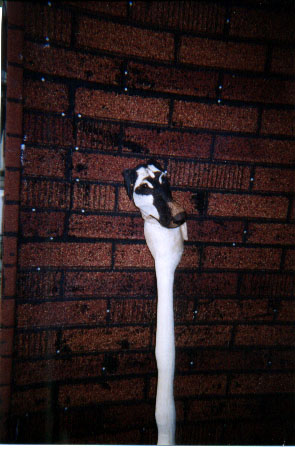 Part-way through
the woodburning stage.
Part-way through
the woodburning stage.
 With the wood burning
complete I now focused on the stick itself. I always want to utilize
the character of the stick, the knots, twists, holes, and grain.
This particular stick had it all. One particular knot, near the
head of the dog was shaped like a heart. Knowing how much this
dog means to my client, I accentuated the heart shape by bringing
it out of the wood. The shaft of the staff has numerous knots,
which I left as they added something special.
With the wood burning
complete I now focused on the stick itself. I always want to utilize
the character of the stick, the knots, twists, holes, and grain.
This particular stick had it all. One particular knot, near the
head of the dog was shaped like a heart. Knowing how much this
dog means to my client, I accentuated the heart shape by bringing
it out of the wood. The shaft of the staff has numerous knots,
which I left as they added something special.
 Now it was time to
add the rubber grip on the bottom, and the leather strap.
Now it was time to
add the rubber grip on the bottom, and the leather strap.
This done I made a last minute decision to find a dog tag for
the sculpture. I had the tag engraved and dated. Finally I use
a Tung'n and Teak Oil to finish the stick. The total time to complete
this piece was 160+ hours.
To see more of Vern's work, click here.
Vern Robinson (Stickman) lives in Thunder Bay, Ontario, Canada. You may visit Vern's web site at http://www.tbaytel.net/vernon, or email him at vernon@tbaytel.net